check engine AUDI RS7 SPORTBACK 2015 User Guide
[x] Cancel search | Manufacturer: AUDI, Model Year: 2015, Model line: RS7 SPORTBACK, Model: AUDI RS7 SPORTBACK 2015Pages: 302, PDF Size: 74.76 MB
Page 193 of 302
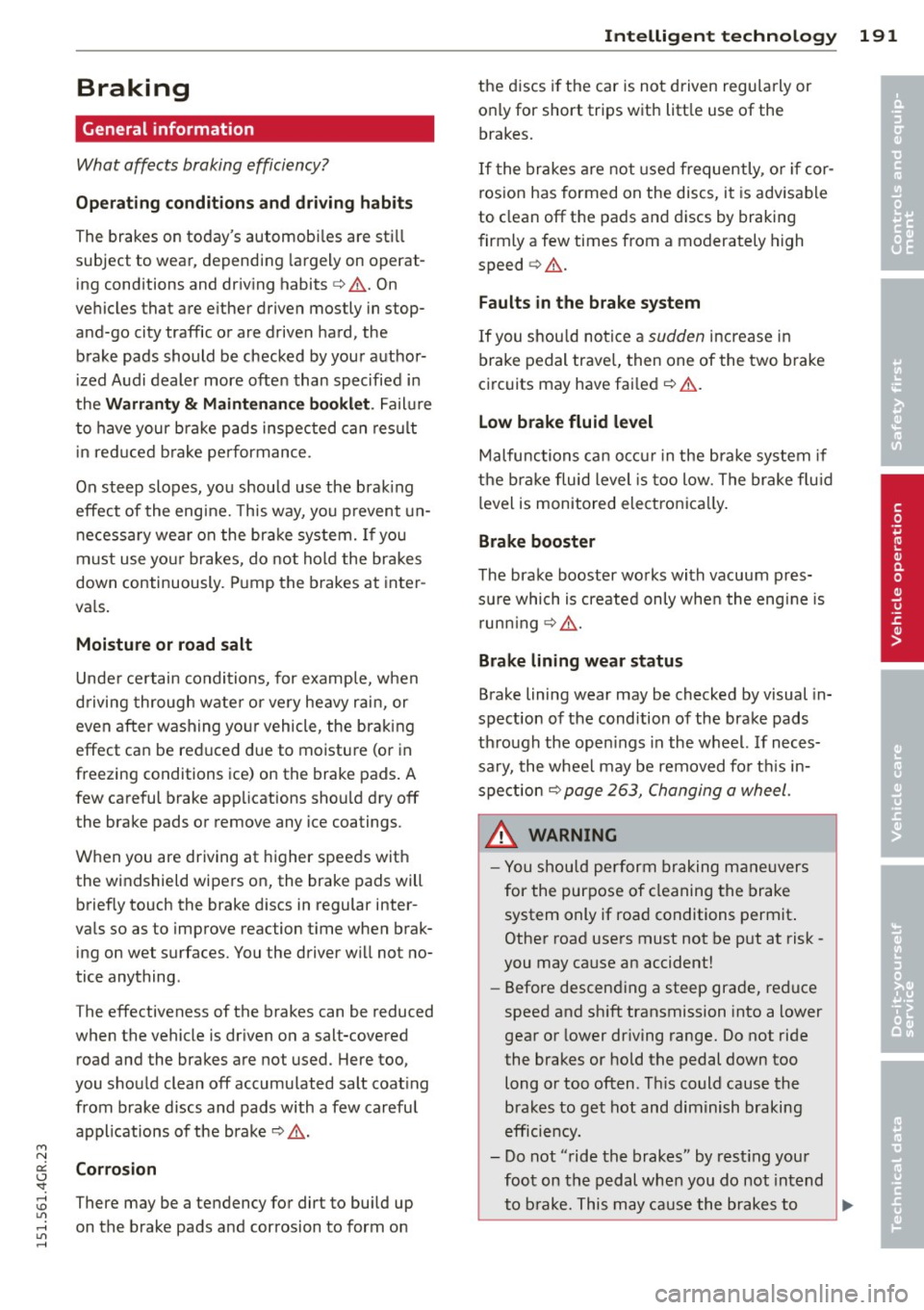
M N
Braking
General information
What affects braking efficiency?
Operating condi tions and d riv ing hab it s
The brakes on today's automobi les are sti ll
subject to wear, depending largely on operat
ing conditions and driving habits
c:> A . On
vehicles that are either driven mostly in stop
and-go city traffic or are driven hard, the brake pads should be checked by your author
i zed Audi dealer more often than specified in
the
Warr ant y & Maint enan ce bookle t. Failure
to have your b rake pads inspected can res ult
i n red uced brake performance.
On steep slopes, you should use the brak ing
effect of the engine. This way, you prevent un
necessa ry wea r on the brake system.
If you
must use yo ur brakes, do not ho ld the brakes
down continuously. Pump the brakes at inter
va ls.
Moistu re or road salt
Unde r ce rtain conditions, for example, when
driving through wate r or very heavy rain, or
even after washing your vehicle, the braking
effect can be reduced d ue to moisture (or in
freezing conditions ice) on the brake pads . A
few careful brake app lications should dry
off
the brake pads or remove any ice coatings.
When you are driving at higher speeds with
the windshield wipers on, the brake pads will
briefly touch the brake discs in regular inter
vals so as to improve reaction t ime when brak
ing on wet surfaces . You the driver w ill not no
tice anything .
The effectiveness of the brakes can be reduced
when the vehicle is driven on a salt-covered
road and the brakes are not used . Here too,
you should clean
off accumulated salt coat ing
from b rake discs and pads with a few careful
applications of the brake
c:> ,&. .
t5 Cor ro sion
'SI: ,...., \!) 1.1'1 ,...., 1.1'1 ,....,
There may be a tendency for dirt to build up
on the brake pads and corrosion to form on
Int ellig ent technolog y 191
the d iscs if the car is not driven regu larly or
only for short trips with litt le use of the
brakes.
If the brakes a re not used frequently, o r if cor
rosion has formed on the discs, it is adv isable
to clean
off the pads and discs by braking
firmly a few times from a moderately high
speed
c:> ,&. .
Fault s in the brak e syste m
If you shou ld notice a sudden increase in
brake pedal trave l, then one of the two brake
circuits may have fai led ¢
A.
Low brake fluid lev el
Malfunctions can occu r in the bra ke system if
the brake fluid level is too low. The brake flu id
level is monitored elect ronica lly.
Brake booster
The brake booster works with vacuum pres
su re which is created only whe n the engine is
runn ing ¢,&. .
Brake lining we ar s tatus
Brake lining wear may be checked by visual in
spection of the condition of the brake pads
through the open ings in the wheel. If neces
sary, the wheel may be removed fo r thi s in
spection ¢
page 263, Changing a wheel.
_& WARNING
-You should perform braking maneuvers
for the purpose of cleaning the brake system only if road conditions permit .
Other road users must not be put at risk -
you may ca use an accident!
- Before descending a steep grade, reduce
speed and sh ift transmission into a lower
gear or lower dr iving range. Do not ride
the brakes or hold the pedal down too long or too often . Th is could cause the
brakes to get hot and diminish braking
efficiency.
- Do not "ride the brakes" by rest ing your
foot on the pedal when you do not intend
to b rake. This may cause the brakes to
•
•
Page 199 of 302
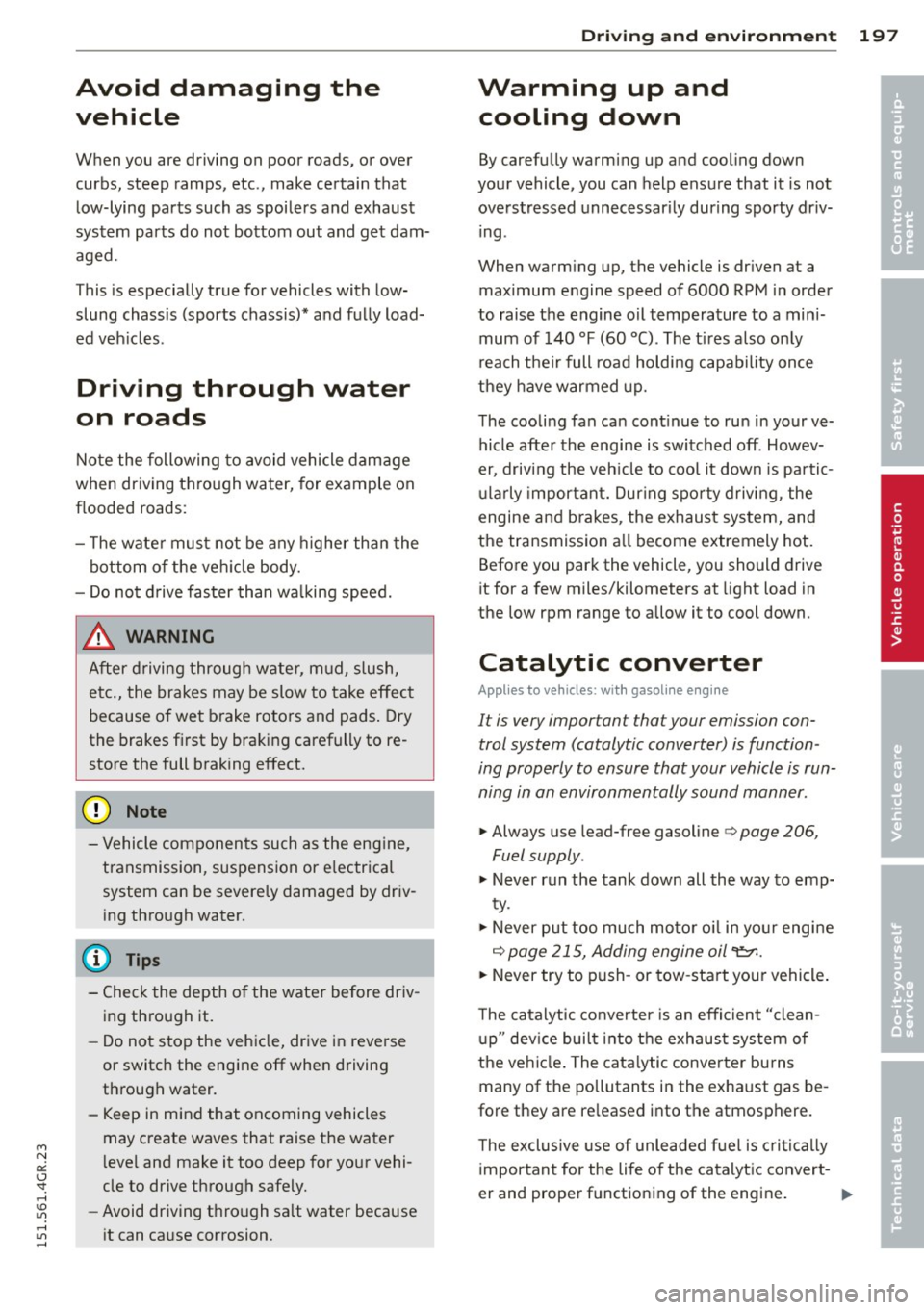
Avoid damaging the
vehicle
When you are driving on poor roads, or over
curbs, steep ramps, etc., make certain that
low-lying parts such as spoilers and exhaust
system parts do not bottom out and get dam
aged.
T his is especially true for vehicles with low
slung chassis (sports chassis) * and fully load
ed veh icles .
Driving through water
on roads
Note the following to avoid vehicle damage
when driving through water, for example on
flooded roads:
- T he water must not be any h igher than the
bottom of the veh icle body.
- Do not d rive faster than wa lking speed.
..&, WARNING
After driving through wate r, m ud, slush,
etc., the brakes may be slow to take effect
because o f wet brake rotors and pads . Dry
the brakes first by braking carefully to re
store the full braking effect.
(D Note
- Vehicle components such as the eng ine,
transmission, suspension or e lectrical
system can be severely damaged by driv ing through water.
- Check the depth o f the water before driv
ing through it.
- Do not s top the veh icle, drive in reverse
or switc h the engine off when driving
through water.
- Keep in mind that oncoming vehicles may create waves that raise the water
level and make it too deep for your vehi
cle to drive through safely.
- Avoid driving thro ugh sa lt water because
-
~ it can ca use corrosion. ,....,
Dri vin g and en vironm ent 197
Warming up and
cooling down
By carefully warming up and cooling down
your vehicle, you can help ensure that it is not
overstressed unnecessar ily during sporty dr iv
ing.
When warming up, the vehicle is dr iven at a
maximum engine speed of 6000 RPM in order
to raise the engine o il temperature to a mini
mum of 140
°F (60 °() . The t ires a lso on ly
reach the ir full road holdi ng capabi lity on ce
they have warmed up.
The cooli ng fan can cont inue to run in your ve
hicle after the engine is switched off . Howev
er, driving the veh icle to coo l it down is pa rti c
ul arly important. Dur ing spo rty driving , the
engine and b rakes, the exhaust system, and
the transmission a ll become extremely hot.
Before you park the vehicle, you should drive
it for a few miles/kilometers at light load in
the low rpm range to allow it to cool down .
Catalytic converter
App lies to vehicles: wi th gaso line e ngi ne
It is very important that your emission con
trol system (catalytic converter) is function
ing properly to ensure that your vehicle is run
ning in an environmentally sound manner.
"' Always use lead-free gasoline c:> page 206,
Fuel supply .
"' Never run the tank down all the way to emp
ty.
"' Never put too much mo to r o il in yo ur eng ine
c:> page 21 S, Adding engine oil "t:::r..
"' Never try to push -or tow -start you r vehicle .
T he catalytic co nve rter is an efficient "clean
u p" dev ice bui lt into t he exhaus t system of
the ve hicle . The cata lytic converter bu rns
many of the pollutants in the exha ust gas be
fore they are re leased into the atmosphere.
T he exclus ive use of unleaded fuel is c ritical ly
i mportant for the life of the catalyt ic convert -
er and proper functioning of the engine .
Iii>
•
•
Page 201 of 302
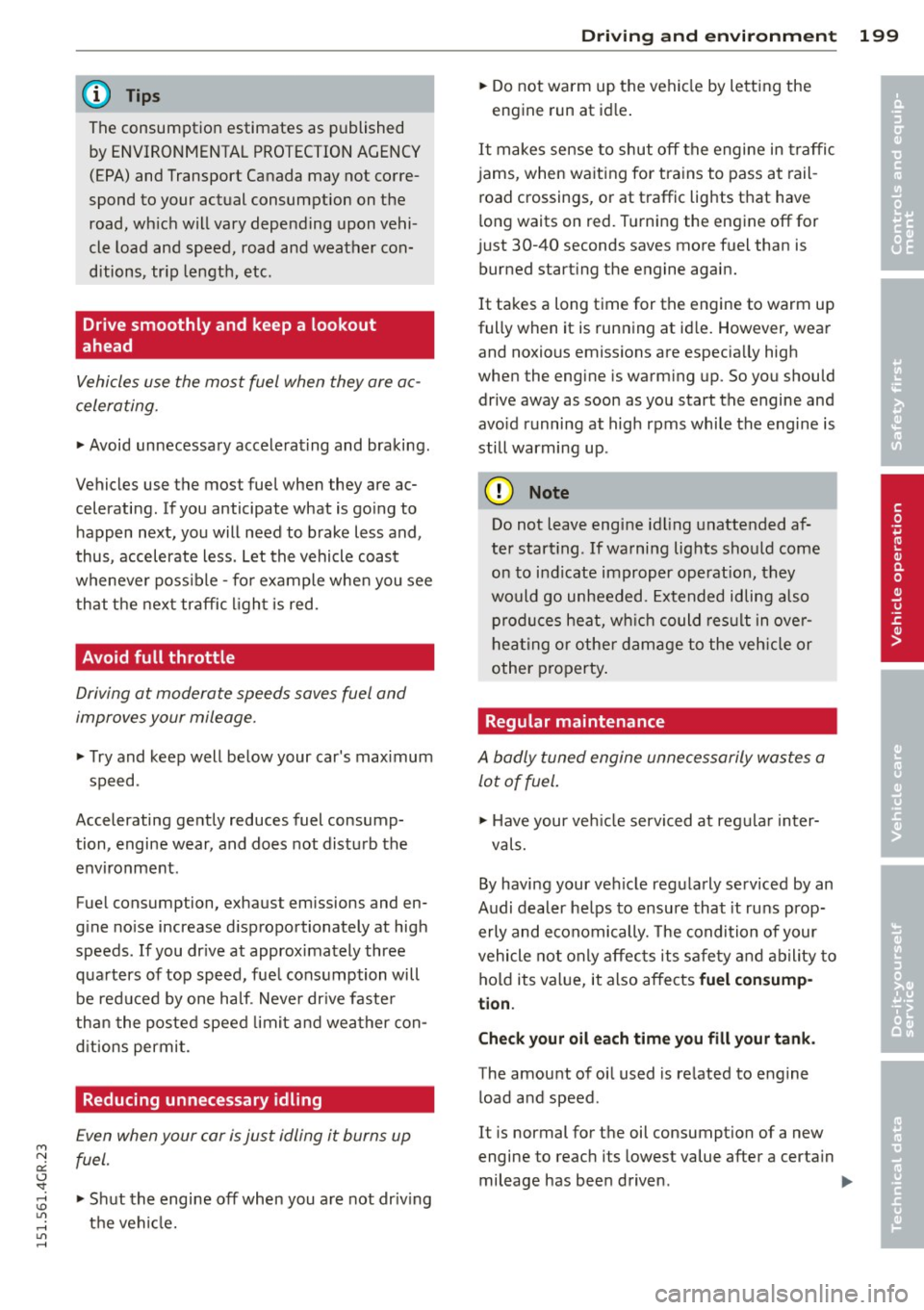
M N
0:: <.J 'SI: ,...., \!) 1.1'1 ,...., 1.1'1 ,....,
@ Tips
The consumption estimates as published by ENVIRONMENTAL PROTECTION AGENCY (EPA) and Transport Canada may not corre
spond to your actual consumption on the
road, which will vary depending upon vehi
cle load and speed, road and weather con
ditions, trip length, etc.
Drive smoothly and keep a lookout
ahead
Vehicles use the most fuel when they are ac
celerating.
~ Avoid unnecessary accelerating and braking.
Vehicles use the most fuel when they are ac
celerating. If you anticipate what is going to happen next, you will need to brake less and,
thus , accelerate less . Let the vehicle coast
whenever possible -for example when you see
that the next traffic light is red.
Avoid full throttle
Driving at moderate speeds saves fuel and
improves your mileage.
~ Try and keep well below your car's maximum
speed.
Accelerating gently reduces fuel consump
tion, engine wear, and does not disturb the
environment .
Fuel consumption, exhaust emissions and en
gine noise increase disproportionately at high
speeds . If you drive at approximately three
quarters of top speed, fuel consumption will
be reduced by one half. Never drive faster
than the posted speed limit and weather con
ditions permit.
Reducing unnecessary idling
Even when your car is just idling it burns up
fuel .
~ Shut the engine off when you are not driving
the vehicle.
Driving and environment 199
~ Do not warm up the vehicle by letting the
engine run at idle.
It makes sense to shut off the engine in traffic
jams , when waiting for trains to pass at rail
road crossings, or at traffic lights that have
long waits on red. Turning the engine off for
just 30 -40 seconds saves more fuel than is
burned starting the engine again.
It takes a long time for the engine to warm up
fully when it is running at idle. However, wear
and noxious emissions are especially high
when the engine is warming up. So you should
drive away as soon as you start the engine and
avoid running at high rpms while the engine is
still warming up .
(D Note
Do not leave engine idling unattended af
ter starting . If warning lights should come
on to indicate improper operation, they
would go unheeded. Extended idling also
produces heat, which could result in over
heating or other damage to the vehicle or
other property.
Regular maintenance
A badly tuned engine unnecessarily wastes a
lot of fuel.
~ Have your vehicle serviced at regular inter-
vals.
By having your vehicle regularly serviced by an
Audi dealer helps to ensure that it runs prop
erly and economically. The condition of your
vehicle not only affects its safety and ability to
hold its value, it also affects
fuel consump
tion.
Check your oil each time you fill your tank.
The amount of oil used is related to engine
load and speed .
It is normal for the oil consumption of a new
engine to reach its lowest value after a certain
mileage has been driven .
IIJ,,
•
•
Page 213 of 302
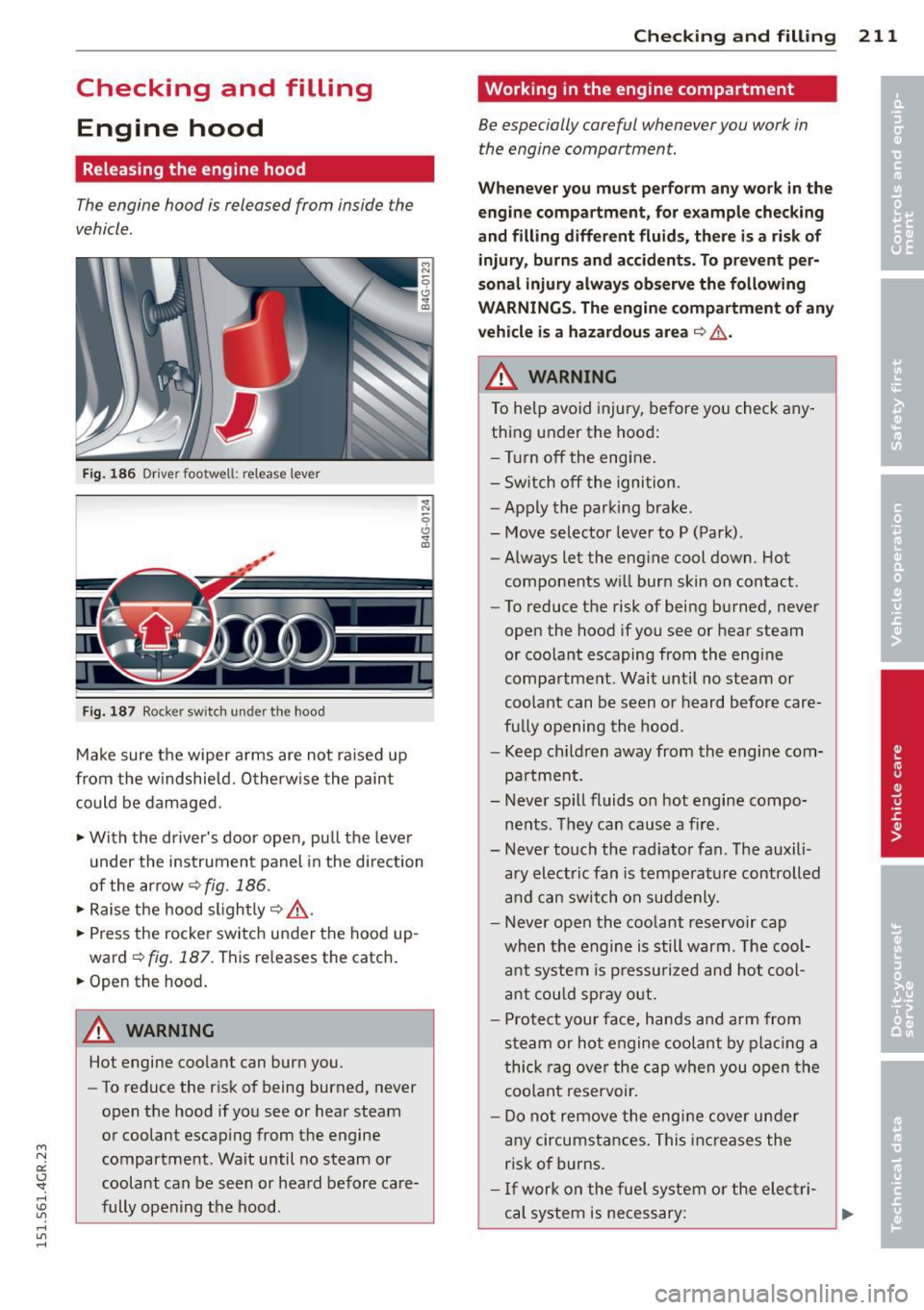
"' N
a:: I.J ""'. rl I.O
"' rl
"' rl
Checking and filling Engine hood
Releasing the engine hood
The engine hood is released from inside the
vehicle .
Fig. 186 Dr ive r foo twell: re lease leve r
Fig. 187 Rocker sw itch under the hood
Make sure the wiper arms are not raised up
from the w indshield. Otherw ise the paint
could be damaged.
.. With the driver's door open , pull the lever
under the instrument panel in the direction
of the arrow
c::> fig. 186.
.. Raise the hood slightly c::> .&. .
.. Press the rocker switch under the hood up
ward
c::> fig. 187 . This releases the catch.
.. Open the hood .
A WARNING
Hot engine coo lant can burn you.
- To reduce the risk of being burned, never
open the hood if you see or hear steam
or coolant escaping from the engine
compartment . Wait until no steam or
coolant can be seen or heard before care
fully opening the hood.
Checkin g and fillin g 211
Working in the engine compartment
Be especially careful whenever you work in
the engine compartment.
When ev er y ou must p erform an y wor k in the
en gine com pa rtm ent , for e xample checking
a nd filling diff ere nt fluid s, th ere is a risk of
inju ry, burn s and accid ent s. To pr eve nt per
so nal injury alwa ys observ e the foll owing
W ARNING S. The engin e compartm ent of any
v e hicle i s a h aza rdou s area
c::> ,& .
h WARNING
To help avoid injury, before yo u check any
thing under the hood:
- Turn off the engine.
- Sw itch off the ignition .
- Apply the parking brake.
- Move selector leve r to P (Park) .
- Always let the eng ine cool down . Hot
components w ill burn skin on contact .
- To reduce the risk of being burned, never
open the hood if you see or hear steam
or coo lant escaping from the engine
compa rtment. Wait unt il no steam or
coolant can be seen or heard before care
fu lly opening the hood.
- Keep ch ildren away from the engine com
pa rtment.
- Never sp ill fluids on hot engine compo
nents . They can cause a fire .
- Never touch the rad iator fan. The auxili
ary electric fan is temperat ure controlled
and can switch on suddenly .
- Never open the coolant reservoir cap
when the engine is still warm . The cool
ant system is p ressu rized and hot cool
a nt cou ld spray o ut.
- Protect your face, hands and arm from
steam or hot engine coolant by plac ing a
thick rag ove r the cap when you open the
coo lant rese rvoir.
- Do not remove the engine cover under
any circumstances. This inc reases the
ris k of burns.
- If work on the fue l system o r the elec tri -
cal system is necessary:
II>-
Page 214 of 302
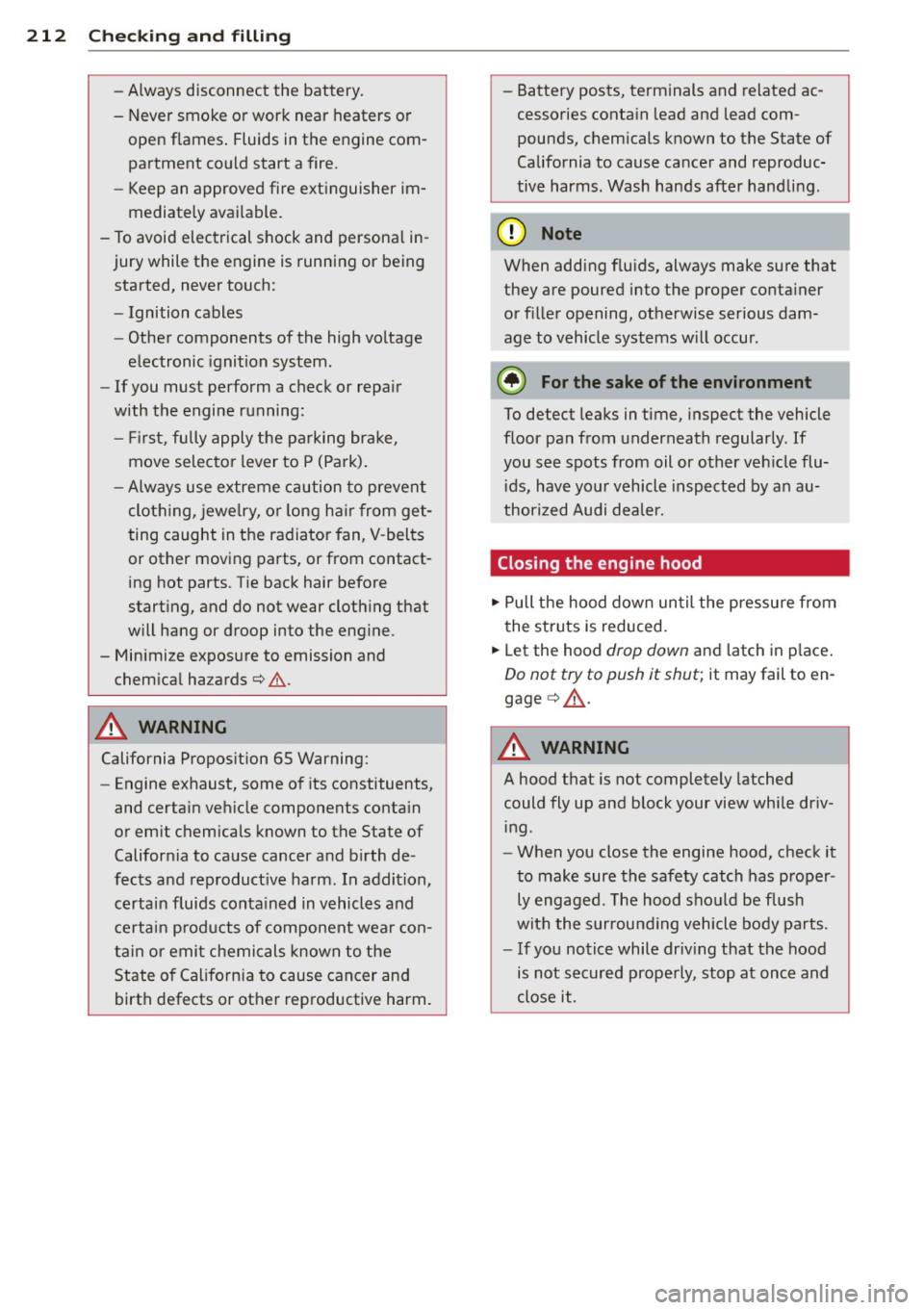
212 Check ing and filling
- Always disconnect the battery.
- Never smoke or work near heaters or open flames . Fluids in the engine com
partment could start a fire.
- Keep an approved fire extinguisher im
mediately available.
- To avoid electrical shock and persona l in
jury while the engine is running or being started, never touch:
- Ignition cables
- Other components of the high voltage
electronic ignition system.
- If you must perform a check or repa ir
with the engine running:
- Fi rst, fully apply the parking bra ke,
move se lec to r lever to P (Pa rk) .
- Always use extreme caution to preven t
clot hing, jewe lry, or long h air from ge t
ting caught in the radiator fan, V -belts
or other moving parts, or from contact ing hot parts. Tie back hair before
start ing, and do not wear cloth ing that
will hang or droop into the eng ine.
- Min imize exposure to emission and
chemica l hazards¢ ,&..
A WARNING
California Propos ition 65 Warning:
- Engine exhaust, some of its constituents,
and certa in veh icle components conta in
or emit chemicals known to the State of
Califor nia to cause cancer and b irth de
fec ts a nd reproduct ive ha rm. In addition,
certain fluids conta ined in vehicles and
certa in prod ucts of co mponent wear co n
ta in o r emi t chemicals known to the
State o f Ca lifornia to cause can cer and
birth defects or ot her reproductive harm. -
Battery posts, terminals and re lated ac
cessories conta in lead and lead com
pounds, chemicals known to the State of
California to cause cance r and reproduc
tive harms. Wash hands after handling .
(D Note
When adding flu ids, always make sure that
they are poured into the proper conta iner
or f iller opening, otherwise serious dam
age to vehicle systems w ill occur.
® For the sake of the environment
To detect leaks in time, inspect the vehicle
floor pan from underneath regularly. If
you see spots from oil or other ve hicle flu
i ds, have yo ur vehicle inspected by a n au
thori zed Audi dea le r.
Closing the engine hood
.,. Pull the hood down un til the pressure from
t he struts is reduced.
.,. Let the hood drop down and latch in p lace .
Do not try to push it shut; it may fail to en
gage ¢&_ .
A WARNING
-
A hood that is not completely latched
could fly up and b lock your view while dr iv
ing.
- When you close the engine hood, check it
to make sure the safety catch has p roper
ly engaged. The hood sho uld be flush
with the surrou nding vehicle body pa rts.
- If you notice while driv ing t hat the hood
is not s ecured prope rly, stop at onc e and
close it.
Page 215 of 302
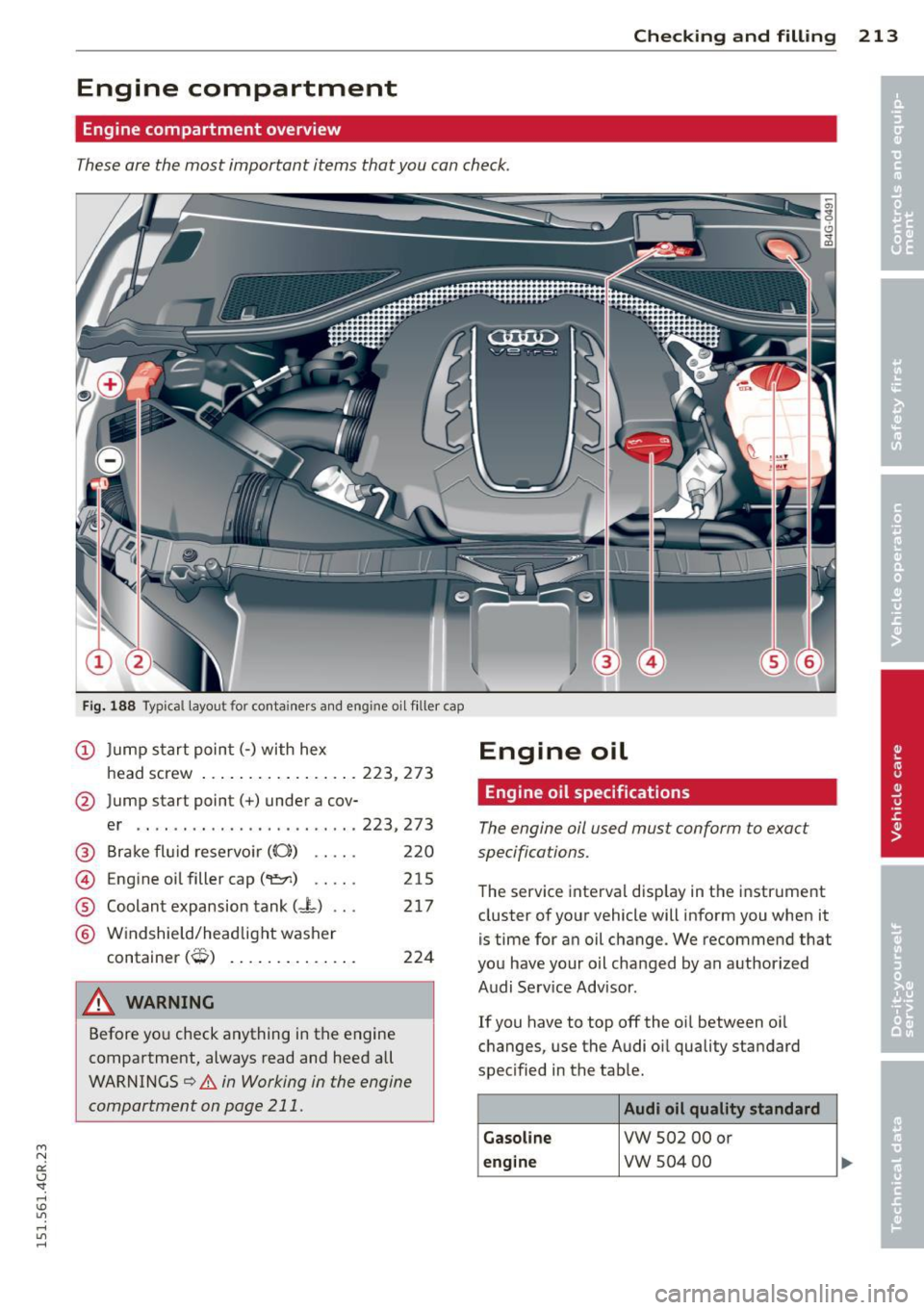
"' N
a:: I.J "". rl I.O
"' rl
"' rl
Checking and filling 213
Engine compartment
Engine compartment overview
These are the most important items that you can check.
Fig. 1 88 Typical l ayout for conta iners a nd engine o il filler cap
@ Jump s tart p oin t(-) with hex
head screw .. .. ..... ... .. .. . 223, 273
@ Jump start point(+) under a cov-
er .. .. ... ..... ...... ...... 223, 273
@ Bra ke fl uid reservo ir ((0)) . . . . . 220
© Eng ine oi l filler cap ("1:::r.) . . . . . 215
® Coolant expansion tank (-L) . . . 217
@ W indshie ld/headlight washer
container
(0) . . . . . . . . . . . . . . 224
_& WARNING
Before yo u check anything in the engine
compartment, always read and heed all
WARNINGS
Q .&. in Working in the engine
compartment on page 211.
-
Engine oil
Engine oil specifications
The engine oil used must conform to exact
specifications.
T he service interva l d isp lay in t he instr ument
cluster of yo ur vehicle will inform you when it
is time for an oil change. We recommend that
you have your oil changed by an authorized
Audi Se rv ice Advisor .
If you have to top off the oi l between oi l
c hanges, use the Audi o il quality standard
spec ified in the table.
Audi oil quality standard
Gasoline
VW 502 00 or
engine vw 504 00
Page 216 of 302
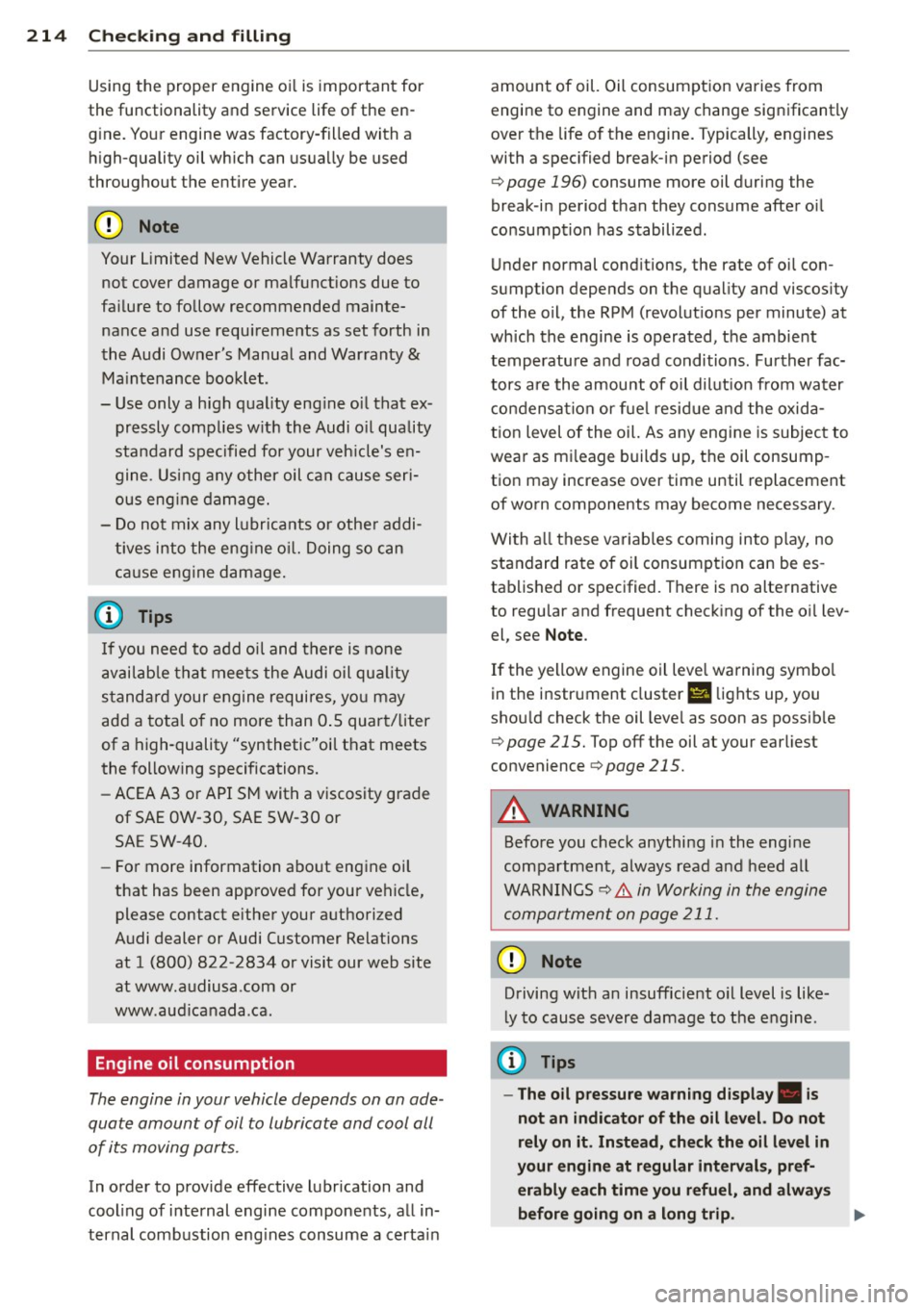
214 Check ing and filling
Using the proper engine o il is important for
the functionality and service life of the en
g ine . Your engine was factory-filled with a
hi gh-quality oil which can usua lly be used
throughout the enti re year.
0 Note
Y our Limited New Vehicle Warranty does
not cover damage or ma lf u nctions due to
fa ilure to follow recommended mainte
nance and use requ irements as set forth in
the Audi Owner's Manual and Warranty
&
Ma intenance boo klet.
- Use only a high quality eng ine oi l that ex
pressly complies w ith the Audi o il quality
sta ndard spec ified for your veh icle's en
gine . U sing any other oil can cause seri
ous eng ine damage.
- Do not mix any l ubr ica nts o r othe r addi
tives into the eng ine o il. Doing so c an
ca use eng ine dam age.
I f you need to add oi l and there is no ne
availab le tha t mee ts the Audi o il qua lity
s tandar d your engine requires, yo u may
ad d a tota l of no more than 0 .5 quart/liter
of a high-quality "synthetic"oil that meets
the following specifications.
- ACEA A3 or API S M with a viscosity grade
of SAE 0W-30, SAE SW-30 or
SAE SW -40.
- Fo r more information abo ut engine oi l
that has been app roved for your vehicle,
please contact either your a uthori zed
Audi dealer or Audi Customer Relations
at 1 (800) 822 -2834 or visit our web site
at www.audiusa .com or
www .aud icanada .ca .
Engine oil consumption
The engine in your vehicle depends on an ade
quate amount of oil to lubricate and cool all
of its moving parts.
In order to provide effective lubrication and
cooling of i nternal engine components, a ll in
ternal comb ustion eng ines consume a certa in amount of oil. Oil consumpt
ion varies from
engine to engine and may change significant ly
over the life of the engine . Typically, engines
with a spec ified break-in period (see
<=> page 196) consume more oil during the
break -in pe riod than they consume after o il
co nsump tion has stabilized.
Under normal cond itions, the rate of oil con
sumption depends on the q ua lity and viscos ity
of the oil, the RPM (revolut ions per minute) at
wh ich the engine is operated, t he ambie nt
temperature and road conditions . Fur ther fac
tors a re the amount of oil dilut ion from wa ter
condensation or f ue l resid ue and the oxid a
t ion level of the o il. As any engine is subjec t to
wear as m ileage builds up, t he oil consump
tion may increase over time until replacement of wo rn components may become necessary.
W it h a ll these variab les coming into play, no
standard rate of oil consumption can be es
tablished or specified. There is no alte rnative
to regu lar and frequent check ing of the o il lev
el, see
Note .
If
the yellow engine oil level warning symbo l
in the instrument cluster
I!!! lights up, you
shou ld check the oil leve l as soon as possib le
<=> page 215. Top off the oil at your earliest
convenience
<=> page 215.
A WARNING
-Before you chec k anythi ng in the engine
com partment, always read a nd heed all
WAR NIN GS¢
& in Working in th e engine
compar tment on page 211.
{(D Note
Driving w it h an insufficient o il level is like
ly to cause severe damage to the engine .
(D Tips
- The oil pressure warn ing display. is
not an indicator of the oil level. Do not
rely on it . Instead, check the oil lev el in
your engine at regular intervals , pref
erably each time you refuel, and alway s
before going on a long trip. .,.
Page 217 of 302
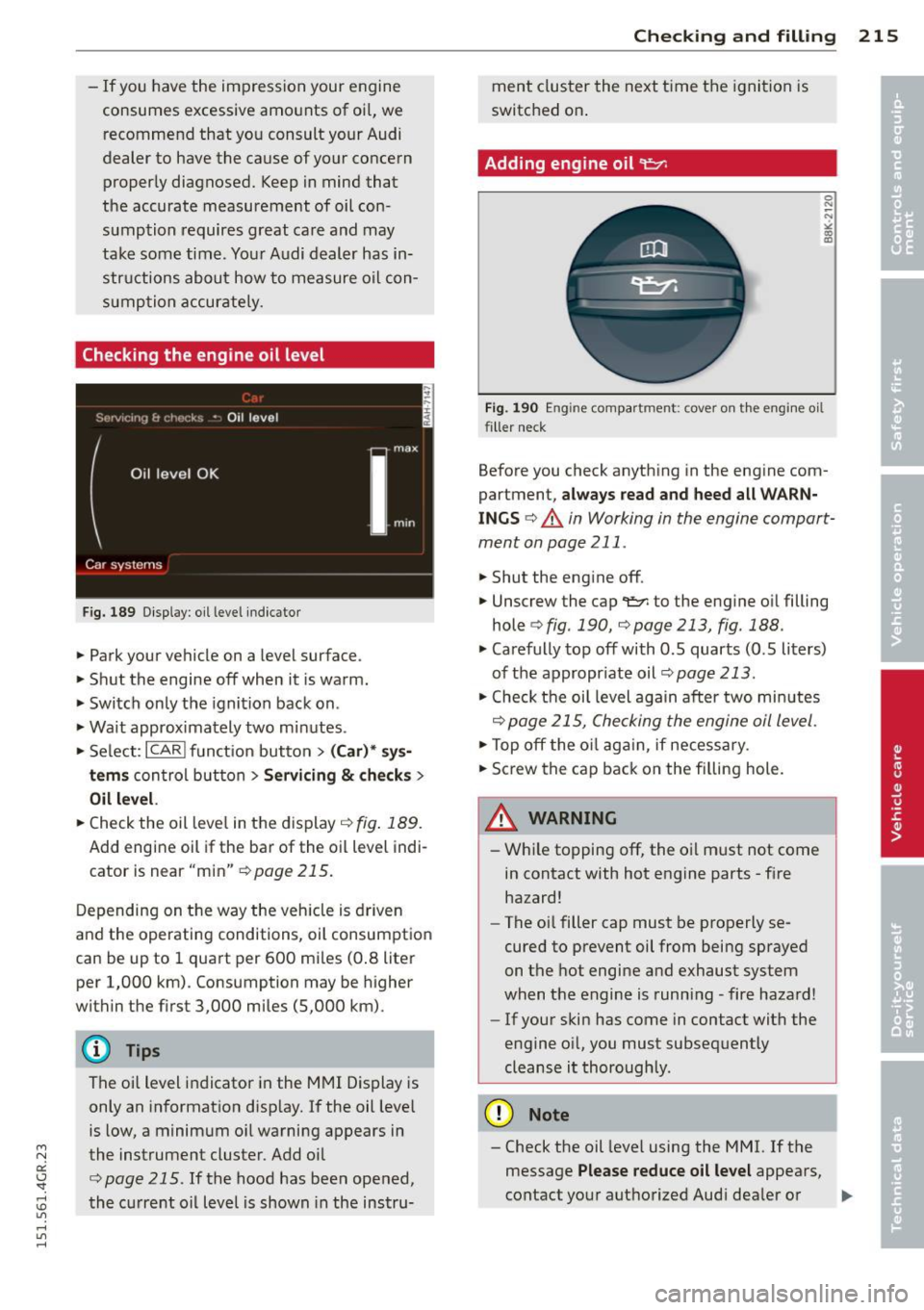
"' N
a:: I.J "". rl I.O
"' rl
"' rl
-If you have the impression your engine
consumes excessive amounts of oi l, we
recommend that yo u consult your Audi
dealer to have the cause of your concern
properly diagnosed. Keep in mind that
the accurate measurement of oil con
sumption requires great care and may
take some time . Your Audi dealer has in
str uctions abou t how to measure oil con
sump tion accurately.
Checking the engine oil level
F ig. 189 Di splay : oil lev el indicato r
.,. Park your vehicle on a level surface .
.,. Shut the engine off when it is warm.
.,. Switch only the ignition back on .
.,. Wa it approximately two minutes .
.,. Se lect :
I C ARI funct ion button > ( Car )* sys
tems
con trol button > Ser vici ng & ch ecks >
Oil level.
.,. Check the oil leve l in the display ¢ fig. 189.
Add engine oil if the bar of the oil level indi
cator is near "min"
r:!;> page 215.
Depending on t he way the veh icle is driven
and the operating conditions, oil consumption
can be up to 1 qua rt per 600 mi les (0 .8 liter
per 1,000 km) . Consumption may be higher
within the firs t 3,000 miles (5,000 km) .
@ Tips
The oil level indicator in the MMI Display is
only an in formation disp lay.
If the oil leve l
is low, a minimum o il warning appears in
the instrument cluster. Add oi l
¢page 215. If the hood has been opened,
the c urre nt oil level is shown in the instru- Checkin
g and fillin g 215
ment cluster the next t ime the igni tion is
switched on .
Adding engine oil~
Fig. 19 0 En gin e co mpa rtm ent: cov er on th e engi ne oi l
filler neck
Before you check anyth ing in the engine com
partmen t,
always read and heed all WARN
INGS¢ A in Working in the engine compart
ment on page 211 .
.,. Shut the eng ine off .
.,. Unscrew the cap
¢ fig . 190, ¢page 213, fig.188 .
.,. Carefully top off with 0.5 quarts (0.5 liters)
of the appropr iate oil¢
page 213 .
.,. Check the oi l level again after two mi nutes
¢ page 215, Che cking the engine oil level .
.,. Top off the o il aga in, if necess ary .
.,. Screw the cap back on the fi lling hole.
A WARNING
- Wh ile topping off, the o il m ust not come
in contact with hot engine parts - f ire
hazard!
- The oi l filler cap must be properly se
cured to prevent oil from being sprayed
o n the hot engine and exhaust system
when the engine is runni ng -fire hazard!
- If your s kin has come in contact with the
e ngine o il, you must subsequently
cleanse it thoroughly .
(D Note
-Check the oil level using the MMI. If the
message
Please reduce oil level appears,
contact you r aut hori zed Aud i dea ler or
Ill>-
Page 218 of 302
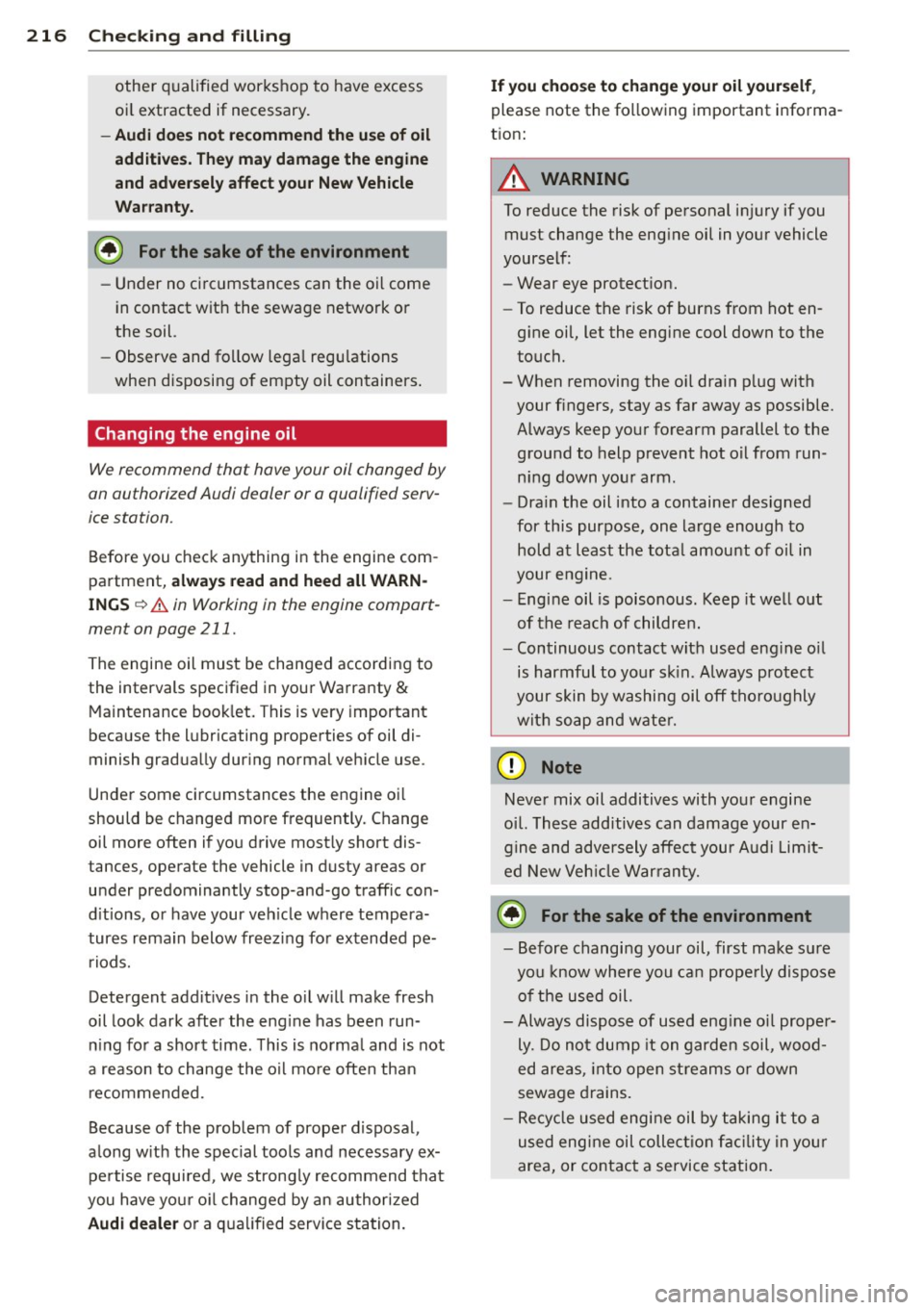
216 Check ing and filling
other qualified workshop to have excess
oi l extracted if necessary.
-Audi do es not re commend th e us e of oil
additi ve s. The y ma y damage the e ngine
and ad ve rs ely a ffect yo ur New Vehicle
Wa rrant y.
@ For the sake of the environment
- Under no circumstances can the oil come
in contact wit h the sewage network or
the soil.
- Observe and follow lega l regu lations
when disposing of empty oil containers .
Changing the engine oil
We recommend that hove your oil changed by
on authorized Audi dealer or a qualified serv
ice station.
Before you check anything in the engine com
partment,
a lw ays r ead and heed all WARN
ING S
~.&. in Working in the engine comport
ment on page 211.
The engine oil must be changed according to
the intervals specified in your Warranty
&
Maintenance booklet. This is very important
because the lubricating properties of oil di
minish gradually dur ing normal vehicle use .
Under some circumstances the engine oil
should be changed more frequently. Change
oil more often if you drive mostly short dis
tances, operate the vehicle in dusty areas or
under predominantly stop-and-go traffic con
d itions, or have your veh icle where tempera
tures remain below freezing for extended pe riods.
Detergent additives in the oil w ill make fresh
oil look dark after the eng ine has been run
n ing for a short time . This is norma l and is not
a reason to change the oil mo re often tha n
recommended.
Because of the problem of proper disposal,
a long w ith the special tools and necessary ex
pe rtise required, we strong ly recommend that
you have yo ur o il changed by an authori zed
Audi de ale r or a qualified service station.
If yo u choo se to chan ge your oil yours elf ,
please note the fo llowing important informa
t ion:
A WARNING "--
To reduce the risk of personal injury if you
must change the engine oil in your vehicle
yourself:
- Wear eye protect ion.
- To reduce the risk of burns from hot en-
g ine oil, let the engine cool down to the
touch.
- When removing the oil dra in p lug with
your fingers, stay as far away as possible.
Always keep your forearm parallel to the
ground to help prevent hot oil from run n ing down your arm.
- Dra in the oil into a container designed
for this purpose, one large enough to hold at least the tota l amount of o il in
your engine.
- Engine oil is poisonous . Keep it wel l out
of the reach of children.
- Continuous contact with used eng ine o il
is harmful to your sk in . Always protect
your skin by washing oil off tho roughly
wit h soap and wate r.
(D Note
Neve r mix oil additives with you r engine
oi l. These additives can damage your en
gine and adversely affect your Audi Limit
ed New Veh icle War ranty.
@ For the sake of the environment
- Before changi ng your oil, first make sure
you know where you can prope rly dispose
o f the used oil.
- Always dispose of used eng ine oi l proper
ly. Do not dump it on garden soil, wood
ed areas, into open st reams o r down
sewage drains.
- Re cycle used engine oil by taking it to a
used eng ine oil collect io n fac ility in you r
area, or contact a service station.
Page 219 of 302
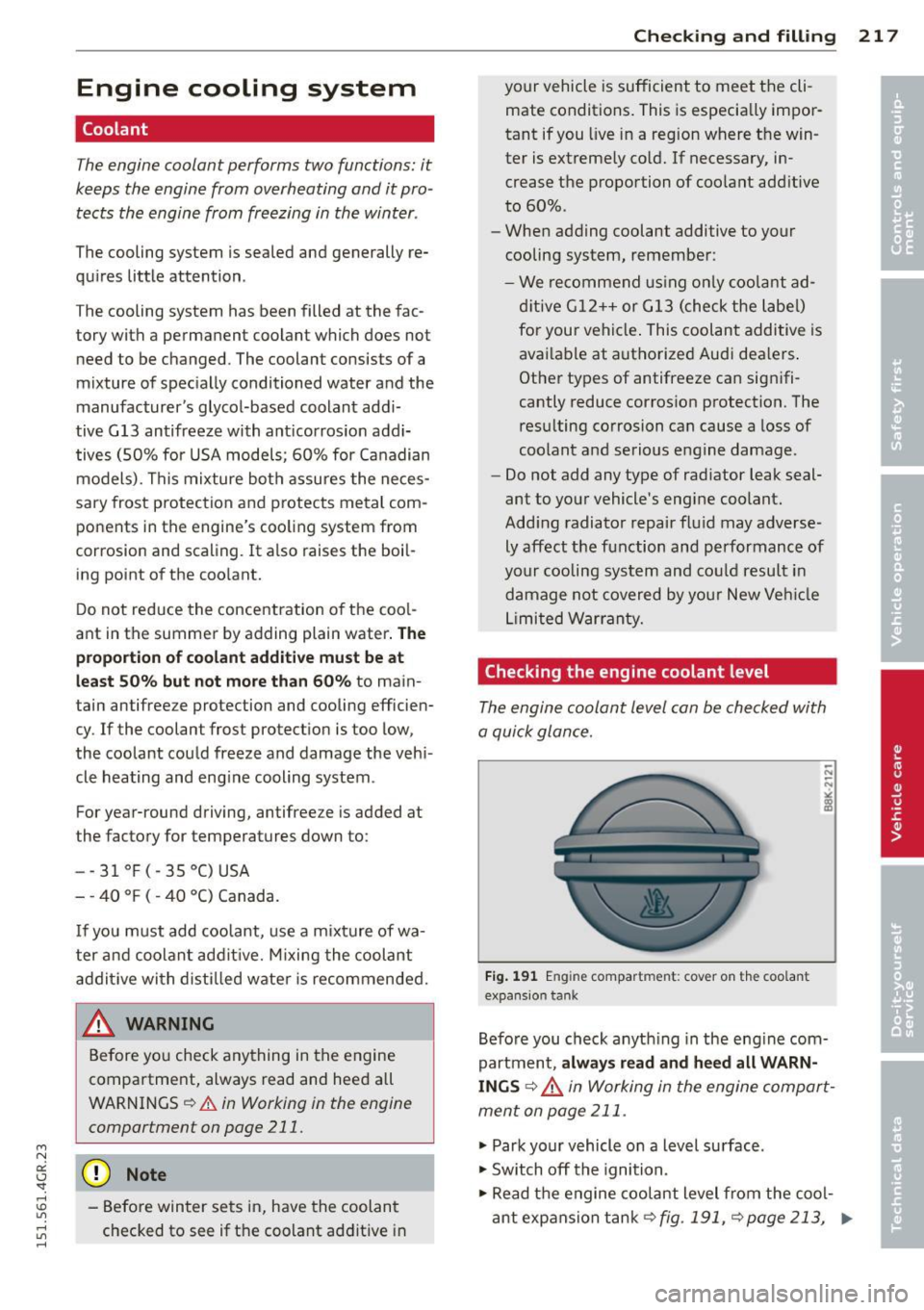
"' N
a:: I.J "". rl I.O
"' rl
"' rl
Engine cooling system
Coolant
The engine coolant performs two functions: it
keeps the engine from overheating and it pro
tects the engine from freezing in the winter .
The cooling system is sealed and generally re
qu ires little attention .
The cooling system has been filled at the fac
tory with a permanent coolant which does not need to be changed. The coolant consists of a
mixture of specially conditioned water and the
manufacturer's glycol-based coolant addi-
tive G13 antifreeze with anticorros ion addi
tives (50% for USA models; 60% for Canadian models) . This mixture both assures the neces
sary frost protection and protects metal com
ponents in the engine's cooling system from
corrosion and scaling.
It also raises the boil
ing point of the coolant.
Do not reduce the concentration of the coo l
ant in the summer by adding plain water .
The
proportion of coolant additive must be at
least 50% but not more than 60%
to main
tain antifree ze protection and cooling efficien
cy. If the coolant frost protection is too low,
the coolant could freeze and damage the vehi
cle heating and eng ine cooling system .
For year-round driving, antifree ze is added at
the factory for temperatures down to:
- -31°F(-35°C)USA
- -40 ° F ( - 40 °C) Canada.
I f you must add coo lant, use a mixture of wa
ter and coolant addit ive. Mixing the coolant
additive with distilled water is recommended.
& WARNING
Before you check anything in the engine
compartment, always read and heed all
WARNINGS ~.&.
in Working in the engine
compartment on page 211.
(D Note
- Before winter sets in, have the coolant
checked to see if the coolant additive in
Checkin g and fillin g 217
your vehicle is sufficient to meet the cli
mate conditions. This is especia lly impor
tant if you live in a region where the win
ter is extremely co ld. If necessary, in
crease the proportion of coolant additive
to 60% .
- When adding coolant additive to your
cooling system, remember :
- We recommend using only coolant ad
ditive G12++ or G13 (check the label)
for your vehicle . This coolant additive is
avai lable at authorized Audi dealers .
Other types of antifreeze can signifi
cantly reduce corrosion protection. The resulting corrosion can cause a loss of
coolant and serious engine damage.
- Do not add any type of radiator leak seal
ant to your vehicle's engine coolant.
Adding radiator repair fluid may adverse
ly affect the function and performance of
your cooling system and could result in
damage not covered by your New Veh icle
Limited Warranty.
Checking the engine coolant level
The engine coolant level can be checked with
a quick glance.
Fig. 191 En gin e compar tment: cover on the coo lant
expansio n tan k
Before you check anyth ing in the eng ine com
partment,
always read and heed all WARN
INGS¢.&, in Working in the engine compart
ment on page 211 .
"'Park your vehicle on a level surface .
"' Sw itch off the ignition.
"' Read the engine coolant level from the cool
ant expansion tank ¢
fig. 191, ¢ page 213, Ill>-